Fiber 链表
数据域和 React Fiber 有所区别,但核心的指针域是一样的。
概览
type Fiber = {
type: FiberType
tag: Tag | React.FC
effectType: EffectType
parent: Fiber
child: Fiber
sibling: Fiber
alternate: Fiber
props: Props
state: Dict
memorize: Dict
effects: Effect[]
effectList: Fiber[]
instance: FiberInstance
stateNode: Fiber
expirationTime: number
isMount: boolean = false
refChild: Fiber
}
Fiber.type
type FiberType = "host" | "hook"
如果一个 Fiber 的 type 值为 "host",那么表示它的实例(Fiber.instance)是原生 DOM 节点。 如果值为"hook",那么表示它的实例是函数组件(React.FC)对应的 Fiber,也就是自己,此时 Fiber.tag 是函数组件(function)。
Fiber.tag
type Fiber = {
tag: Tag | React.FC
}
// Dict 字典类型
type Dict = { [k: string]: any }
namespace React {
// FC 函数组件类型
export type FC<T extends Dict = Dict> = (props: T) => JSX.Element
}
type Tag = keyof HTMLElementTagNameMap | "text"
Fiber.tag 的类型可以是 string 类型,也可以是 function 类型。string 类型就是原生 DOM 节点的 TagNameMap 集合成员,这里在集合中添加了一个新的 tag: "text",用于表示原生 Text 对象,即文本节点。
当 tag 为 string 类型时,Fiber.instance 就是 DOM 实例,为 function 类型时,Fiber.instance 就是函数组件对应的 Fiber
Fiber.effectType
type EffectType = "place" | "delete" | "update"
effectType 有三种类型,替换,删除,更新。
其实还有创建,但是其过程和 place 相似(从无到有不也是一种替换么?),故只要在 reconcile 阶段 和 commit 阶段 处理中稍作判断即可当作 place 处理。
Fiber 指针域(parent, child, sibling)
type Fiber = {
parent: Fiber
child: Fiber
sibling: Fiber
}
Fiber 链表的空间结构

parent
| \
child-sibling
|
child
和 TreeNode 数据结构有所不同,Fiber 添加了一个称做 sibling 的指针域,指向自己的兄弟节点。在 TreeNode 的遍历中可以直接拿到 children 集合,然后使用栈或者队列进行深度优先或者广度优先遍历。而在 Fiber 节点中,采取的是深度优先 + 回溯的办法遍历,优先向下遍历 child-child 链表,到头之后优先回溯到 sibling,再向下遍历 child-child 链表,如果没有 sibling 就回溯到 parent,如果没有 parent 就遍历终止。
Fiber.alternate
type Fiber = {
alternate: Fiber
}
alternate 用于链接到旧的自己。
在 reconcileChildrenArray 阶段中判断 tag 是否相同,相同则标记 effectType:'update',tag 不同或者旧的自己为 null 则标记 effectType:'place',并把旧的自己标记 effectType:'delete'然后提交到 parent 的 effectList 中。
在 commit 阶段的 effectType:update 处理中,利用 alternate 链接到旧的自己并与之 diff props 判断,更新变化的属性到真实 DOM。
Fiber.props
type Dict = { [k: string]: any }
interface Props extends Dict {
children?: Fiber | Fiber[]
ref?: React.RefAttributes<any>
}
如果 Fiber.type 值为'host', 那么 props 表示真实 DOM 数据域,用于描述 DOM 属性。在 commit effectType:'update' 阶段参与属性 diff。
如果 Fiber.type 值为'hook',则 props 用于函数组件传值,例如传递 children。在 updateHookComponent 阶段中将 props 传入函数组件实例并执行,得到新的 elements(VDom tree 的所有孩子节点) 用于 reconcileChildrenArray。
Fiber.state
type Fiber = {
state: Dict
}
Fiber 函数组件状态。在 useState Hook 中读取和更新。
Fiber.memorize
type Fiber = {
memorize: Dict
}
记录 memo hook 上次的输入。
Fiber.effects
type Effect = (...args: any) => Effect | void
type Fiber = {
effects: Effect[]
}
Fiber 函数组件中的副作用操作,在该 Fiber 最终的 commit 阶段执行。 如果 effect 执行后返回了新的函数,则保存新的函数到 effects 中,在 commit effectType:'place'阶段和 commit effectType:'delete'执行。
使用 Fiber.isMount 来确定副作用是否需要 commit,如果组件已经 Mount,则保持 effects。
Effect 是一个自函子类型,将自身映射为自身类型,其实应该算是 Monad 了。其实函数本身就是个 Monad,函数本身就实现了 return (高阶化) 和>>= (函数执行降阶)。
Fiber.effectList
type Fiber = {
effectList: Fiber[]
}
用于向上收集打上 effectType 标记的 Fiber 节点,最终收集到 rootFiber。在 commit 阶段遍历 effectList 中所有 Fiber。
Fiber.instance
type FiberInstance = Fiber & HTMLElement
type Fiber = {
instance: FiberInstance
}
Fiber 实例,当 Fiber.type 值为'host'时,instance 就是真实 DOM,值为'hook'时,instance 就是函数组件对应 Fiber(自己)。
Fiber.stateNode
type Fiber = {
stateNode: Fiber
}
在 rootFiber 实例(rootContainer 也就是 div#root 节点) 上链接到 rootFiber。
Fiber.expirationTime
type Fiber = {
expirationTime: number
}
Fiber 完成一次 reconcile 所需要的最少时间。
Fiber.isMount
type Fiber = {
isMount: boolean
}
标记 Fiber Mount 状态
Fiber.refChild
type Fiber = {
refChild: Fiber
}
当 Fiber.effectType 为'delete'时将自己的 sibling 标记到 parent 的 refChild 属性,用于 commit effectType:'place'阶段的 insertBefore。 在 commit effectType:'place'阶段会判断 parent 上的 refChild 属性是否为空,如果为空则表示 create 操作(append),如果不为空则表示 place 操作(insertBefore)。